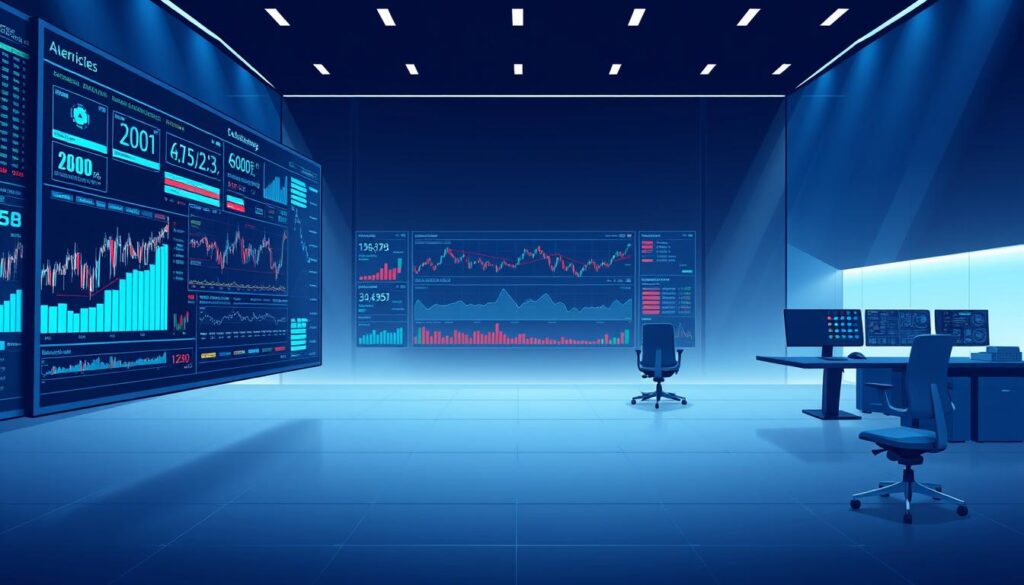In today’s fast-paced markets, staying ahead requires more than just intuition. Advanced tools like machine learning and real-time analysis are transforming how traders operate. These technologies help identify subtle price discrepancies and execute trades with precision.
Unlike traditional methods, modern strategies rely on algorithms to process vast amounts of market data quickly. This allows traders to spot arbitrage opportunities and act before they vanish. The speed and accuracy of these tools provide a significant advantage in volatile markets.
By integrating machine learning models, traders can analyze patterns and sentiment to make informed decisions. This approach not only enhances performance but also helps manage risk effectively. Whether you’re a seasoned trader or just starting, understanding these tools can unlock new levels of success.
Introduction: The Evolution of Financial Arbitrage
From manual calculations to lightning-fast algorithms, trading has evolved significantly. In the past, traders relied on intuition and basic tools to spot price discrepancies. Today, advanced technology and machine learning have revolutionized the process, making it faster and more efficient.
From Traditional Trading to AI-Driven Strategies
Traditional methods involved manual analysis and slow execution. Traders had to sift through data manually, often missing fleeting arbitrage opportunities. With the rise of algorithms, the game changed. These systems process vast amounts of market data in seconds, identifying patterns and executing trades with precision.
AI-driven strategies take this a step further. By leveraging machine learning models, traders can predict market movements and manage risk more effectively. This shift has made trading more accessible and profitable for both beginners and experts.
The Changing Landscape in 2024
In 2024, the trading landscape continues to evolve. Real-time data integration and advanced analytics are now standard. Tools like crypto arbitrage bots and cross-market trading platforms are reshaping how traders operate. These innovations allow for faster execution and better decision-making in volatile markets.
Understanding these trends is crucial. As market conditions change, staying informed about new tools and strategies can give you a competitive edge. Whether you’re exploring crypto or traditional assets, embracing these advancements can unlock new opportunities.
Understanding AI-Powered Financial Arbitrage: Profiting from Data Insights
Modern trading strategies now rely on advanced tools to uncover hidden opportunities. Unlike traditional methods, these systems use machine learning and real-time analysis to identify price discrepancies across markets. This approach allows traders to act swiftly and maximize their profit margins.
One of the key advantages of these tools is their ability to process vast amounts of market data. By analyzing historical and real-time information, they can spot arbitrage opportunities that might otherwise go unnoticed. This level of precision is crucial in today’s fast-paced trading environment.
Advanced algorithms play a vital role in transforming raw data into actionable insights. These models can predict market movements and identify patterns that human traders might miss. For example, firms like Citadel LLC use these systems to make split-second decisions, giving them a significant edge.
The synergy between human expertise and automation is another critical factor. While machines handle data processing and analysis, traders can focus on strategy and risk management. This combination ensures better decision-making and consistent profits.
Predictive analytics and pattern recognition are also essential. By leveraging these techniques, traders can anticipate market shifts and execute trades at the right moment. This approach not only enhances performance but also minimizes risk in volatile conditions.
In summary, these tools are transforming how traders operate. By combining speed, accuracy, and human insight, they unlock new levels of success in the market. Whether you’re a beginner or an expert, embracing these advancements can give you a competitive advantage.
The Role of Machine Learning in Accelerating Arbitrage Opportunities
The integration of machine learning into trading has reshaped how opportunities are identified and acted upon. These models analyze vast amounts of market data to spot patterns and discrepancies that human traders might miss. This approach allows for faster and more accurate decision-making, giving you a significant edge.
One of the key advantages of machine learning is its ability to refine trading signals. By learning from historical patterns, these models can predict future price movements with remarkable accuracy. This reduces the guesswork and helps you focus on the most promising arbitrage opportunities.
Automated data processing is another game-changer. Algorithms can sift through millions of data points in seconds, identifying trends and executing trades at lightning speed. This level of efficiency is crucial in today’s fast-paced market, where opportunities can vanish in an instant.
Adaptive algorithms further enhance this process. These systems evolve with changing market conditions, ensuring they remain effective even in volatile environments. This adaptability not only improves performance but also minimizes risk, making it easier for you to stay ahead.
Reduced latency is another major benefit. By leveraging modern technology, these systems can execute trades in milliseconds, capitalizing on fleeting opportunities before they disappear. This speed translates into real profit gains, giving you a tangible advantage.
Finally, machine learning enhances risk mitigation. By analyzing real-time data, these models can identify potential threats and adjust strategies accordingly. This proactive approach ensures you’re always prepared, no matter how the market shifts.
Real-Time Data Processing and Its Impact on Trading Speed
Speed is the cornerstone of success in today’s trading world. In fast-paced markets, the ability to process information quickly can mean the difference between capturing an arbitrage opportunity and missing it entirely. Real-time data processing has become essential for traders aiming to stay ahead.

Data Quality and Integration Across Markets
Effective trading relies on accurate and consistent data. Poor data quality can lead to missed opportunities or incorrect decisions. Integrating data from multiple markets ensures you have a complete picture of price movements and trends.
Advanced algorithms help streamline this process. They filter out irrelevant information and focus on what matters most. This ensures you’re working with the most reliable data available.
Minimizing Latency for High-Frequency Trades
In high-frequency trading, even a millisecond delay can be costly. Reducing latency is critical to executing trades at the right moment. Firms invest heavily in low-latency networks to ensure they can act faster than competitors.
Modern tools and technology play a key role here. They process vast amounts of data in seconds, allowing you to capitalize on fleeting opportunities. This speed gives you a significant edge in volatile markets.
By minimizing latency, you can reduce slippage and maximize profit. This is especially important when dealing with small price discrepancies that disappear quickly.
Diverse AI Trading Bots: Statistical, Triangular, and Latency Arbitrage
The world of trading has seen a surge in advanced tools designed to maximize efficiency and returns. Among these, AI-powered bots have become essential for identifying and acting on arbitrage opportunities. These bots come in various models, each tailored to specific strategies and market conditions.
Identifying Different Arbitrage Bot Models
Statistical arbitrage bots rely on historical data to predict price movements. By analyzing patterns, they identify discrepancies and execute trades to capitalize on them. This approach is particularly effective in stable markets where trends are more predictable.
Triangular arbitrage bots operate within a single exchange, using currency loops to exploit price differences. For example, they might trade between Bitcoin, Ethereum, and Litecoin to lock in profits. These bots are ideal for cryptocurrency markets, where volatility creates frequent opportunities.
Latency arbitrage bots focus on speed. They exploit temporal differences in price updates across exchanges. By executing trades faster than competitors, they secure profits before the market adjusts. This strategy requires advanced technology to minimize delays.
AI Versus Traditional Automated Bots
Traditional bots follow predefined rules, limiting their adaptability. In contrast, AI-powered bots use machine learning to evolve with the market. They analyze real-time data, refine their strategies, and manage risk more effectively.
AI bots also excel in complex scenarios. For instance, they can handle multiple currencies or assets simultaneously, diversifying their approach. This flexibility gives them a significant edge in volatile markets.
While traditional bots are simpler to set up, they often miss fleeting opportunities. AI bots, with their ability to learn and adapt, consistently outperform their rule-based counterparts. This makes them a valuable tool for modern traders.
Advanced Techniques: Data Analysis, Pattern Recognition, and Risk Management
To excel in modern trading, mastering advanced techniques is essential. These methods go beyond basic strategies, focusing on data analysis, pattern recognition, and risk management. By leveraging these tools, you can refine your approach and stay ahead in a competitive market.

Leveraging Predictive Analytics for Market Trends
Predictive analytics is a game-changer in trading. It uses historical and real-time data to forecast future market movements. By identifying patterns, you can anticipate trends and act before they fully develop. This approach reduces guesswork and increases your chances of success.
For example, firms like Goldman Sachs use predictive models to analyze vast amounts of market data. These systems spot subtle changes and provide actionable insights. This allows traders to make informed decisions and capitalize on emerging opportunities.
Implementing Robust Risk Management Strategies
Effective risk management is crucial for long-term success. Advanced tools help you monitor and adjust your positions based on real-time market conditions. By integrating predictive models, you can identify potential threats and take proactive measures.
Continuous monitoring is another key factor. Markets evolve, and so should your strategies. Regularly retraining your models ensures they remain effective, even in volatile environments. This adaptability minimizes risk and maximizes profit potential.
In summary, advanced techniques like predictive analytics and robust risk management are essential for modern traders. By mastering these tools, you can refine your strategies and achieve consistent results in a dynamic market.
Implementing AI Arbitrage Solutions in Modern Markets
The rise of decentralized finance has opened new doors for automated trading strategies. By integrating machine learning with decentralized platforms, traders can unlock new levels of efficiency and profitability. These solutions are particularly effective in the fast-paced world of cryptocurrency exchanges.
One of the key challenges in this space is the complexity of market data. With multiple exchanges and assets, analyzing price differences manually is nearly impossible. AI-powered tools streamline this process, identifying arbitrage opportunities in real-time.
Smart contracts and API connections play a crucial role in this integration. They enable seamless communication between platforms, ensuring trades are executed quickly and accurately. This reduces latency and maximizes profit potential.
Integrating AI with DeFi and Cryptocurrency Exchanges
Decentralized finance (DeFi) platforms offer unique opportunities for arbitrage trading. However, they also come with challenges like liquidity fragmentation and price volatility. AI solutions address these issues by analyzing multiple liquidity pools and identifying the best price discrepancies.
For example, platforms like Cryptohopper use algorithms to monitor multiple exchanges simultaneously. This allows traders to capitalize on small price differences across markets. The result is improved liquidity and faster execution.
Another advantage is enhanced market access. AI tools can analyze global markets, providing insights that were previously out of reach. This gives traders a competitive edge, especially in volatile conditions.
To adapt your trading infrastructure, start by integrating reliable APIs and smart contracts. Ensure your systems can handle high-frequency trades and process large volumes of market data. With the right setup, you can leverage these modern solutions to stay ahead in the market.
Developing Robust AI-Driven Arbitrage Software: Best Practices
Building reliable software for trading requires a focus on both technical excellence and strategic planning. To succeed in this competitive field, you need to integrate advanced tools while ensuring your system is scalable, secure, and compliant with regulations.
API Integration, Scalability, and Security
Seamless API integration is critical for connecting your software to multiple exchanges. This allows you to access real-time market data and execute trades efficiently. Platforms like Binance and Kraken offer robust APIs that support high-frequency trading.
Scalability ensures your system can handle increasing market demands. As your trading volume grows, your software must process more data without compromising speed. Implementing cloud-based solutions can help achieve this.
Security is another essential factor. Protecting sensitive trading data requires encryption, two-factor authentication, and regular audits. These measures reduce the risk of breaches and ensure your system remains trustworthy.
Ensuring Regulatory Compliance and Data Protection
Regulatory compliance is a must in the trading industry. Your software should adhere to standards like KYC and AML to avoid legal issues. Detailed trade logs and audit trails can help you stay compliant.
Data protection is equally important. Use advanced encryption methods to safeguard user information. Regularly update your security protocols to address emerging threats.
Testing and backtesting are crucial for refining your software. Simulate real-world market conditions to identify potential issues. Iterative improvements ensure your system remains effective and reliable.
By focusing on these best practices, you can develop a high-performance trading solution that delivers consistent results. This approach not only enhances your profit potential but also builds trust with your users.
Conclusion
The landscape of trading has been reshaped by innovative technologies and advanced strategies. Throughout this article, we’ve explored how tools like machine learning and real-time data processing have transformed the way traders operate. These advancements allow for faster decision-making and the ability to spot price discrepancies with precision.
Adopting advanced algorithms can significantly enhance your trading strategy. They help manage risk effectively while maximizing profit potential. Staying informed about evolving market trends ensures you remain competitive in this dynamic field.
As the trading world continues to evolve, embracing these tools is essential. Explore further resources and best practices to optimize your approach. By leveraging modern technologies, you can unlock new opportunities and achieve consistent success.
